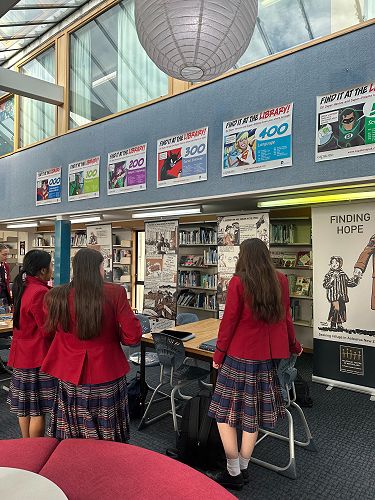Beyond the Books: Our Students Engage with Holocaust History
By Savannah de Vos | Posted: Wednesday September 3, 2025
Students from different year levels recently engaged in a powerful, shared experience, exploring the history of the Holocaust through personal stories and powerful exhibitions.
Our Year 10 Social Inquiry students have just wrapped up a Human Rights unit, where they learned about the formation of the United Nations after the devastation of World War Two. Our Year 12 History students have also finished a unit on the various perspectives and roles within the Holocaust. Additionally, our Year 13's have been learning about the creation of the State of Israel and the push factors that drove Jewish people out of Europe in the 1930's and 1940's.
A wide range of Social Sciences classes engaged with the Holocaust Centre of New Zealand’s Finding Hope Exhibition in the school library. They read the informational panels, completed a source analysis quiz, and reflected on their key learning. It was also wonderful to see students from different year levels stopping at the exhibition during their breaks to learn more about New Zealand's connections to the Holocaust. Our librarian, Colette, also curated a special set of fiction and non-fiction texts for students to select from related to the Shoah and World War Two.
The Year 10 cohort and a few keen Senior History students also listened to Ruth Groffman, a Dunedin local, share her familial connections to the Holocaust. Ruth's two older brothers were killed in concentration camps, while her father survived Buchenwald and her mother survived Auschwitz. We are so grateful to Ruth for giving up her time to share her family's story with our students. It was an incredibly powerful and moving experience.
Year 10 students, Agna Shobin, Aleena Reji and Maryann Vishal share their astute reflections based on Ruth’s talk:
“Ruth Groffman played a huge role in marking a conclusion to our Human Rights unit by teaching us that the Holocaust was a real-life event that took millions of lives, and not just a story written in history books. Her two beloved older brothers were taken away from her parents, forced into gas chambers, filled with a deadly gas named asphyxiant. Their lives were stolen in one of history's most horrific acts of cruelty, leaving behind a grief for generations. Even though she has never had a personal connection with her siblings, as they passed away before she was even born, her continued remembrance of them and her work in the human rights sector shows this relationship.
Hearing her share her family’s story was both powerful and devastating. Her words were calm but carried a lot of depth, making us reflect on what 6 million Jewish people endured. The presence of Ruth inspired us to be more resilient in life. Her life symbolises the continual seeking of justice, the need to protect democracy, and the courage of using one’s voice.”
Year 11 History Student Phoebe Bell reflects on the Finding Hope Exhibition:
“From what I have learned in Year 11 History this year, the 1930's were a challenging time period, especially in Germany. This week, eight information boards were set up in the library, describing New Zealand’s contributions, both positive and negative, to the Second World War. I was surprised to learn that New Zealand was unwelcoming to Jewish refugees fleeing from Europe, some even being labeled as 'enemy aliens' or 'race aliens' during WWI and WWII. This contrasts sharply with the positive contribution of many Kiwi soldiers who helped liberate the San Sabba Concentration Camp in Northeast Italy. This camp saw around 5,000 Jews murdered, with thousands more being shipped to camps at Auschwitz, Buchenwald, and Dachau. Because of New Zealand’s contribution, the United States Holocaust Memorial Museum in Washington, D.C., displays the NZ flag as one of the five liberating nations.”
Year 12 History Student Adam Irvine also shares his key learning from the panels:
“Recently, nine storyboards have been displayed in our school library, exhibiting various topics such as the rise of Nazi persecution, as well as New Zealand refusing some Jewish communities from entering the country. In these panels, it also displays the perspectives of survivors who started their lives again. These topics relate to us as a year group, as we have been studying the Holocaust for our most recent assessment, which makes this information significant as well as relevant to our learning.”
Finally, Year 13 Student Demi Bethune states:
“Today we had the fortune of reviewing panels of the Holocaust memorial from Wellington, New Zealand, thanks to Savannah de Vos for organising this and the Holocaust Centre for providing them. Using these panels, we were able to learn some very useful information for our current 3.4 assessment. Some interesting things I learned were the anti-Semitic sentiment in New Zealand at the time, the stories of Holocaust victims who moved to New Zealand, and the founding of the Holocaust Centre in New Zealand.”



